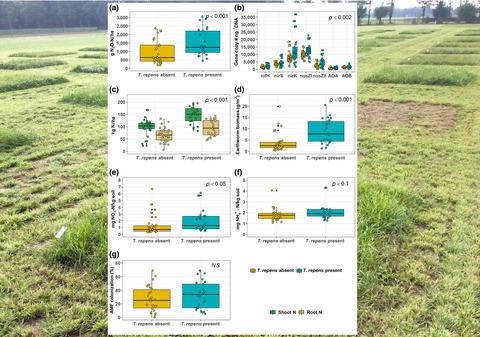当前位置:
X-MOL 学术
›
J. Appl. Ecol.
›
论文详情
Our official English website, www.x-mol.net, welcomes your feedback! (Note: you will need to create a separate account there.)
Manipulating plant community composition to steer efficient N‐cycling in intensively managed grasslands
Journal of Applied Ecology ( IF 5.7 ) Pub Date : 2020-11-01 , DOI: 10.1111/1365-2664.13788 Diego Abalos 1, 2 , Gerlinde B. De Deyn 1 , Laurent Philippot 3 , Natalie J. Oram 1 , Barbora Oudová 1, 4 , Ioannis Pantelis 1 , Callum Clark 1 , Andrea Fiorini 5 , David Bru 3 , Ignacio Mariscal‐Sancho 6 , Jan Willem Groenigen 1
中文翻译:

操纵植物群落组成,以在集约化管理的草地中引导有效的N循环
更新日期:2021-01-07
Journal of Applied Ecology ( IF 5.7 ) Pub Date : 2020-11-01 , DOI: 10.1111/1365-2664.13788 Diego Abalos 1, 2 , Gerlinde B. De Deyn 1 , Laurent Philippot 3 , Natalie J. Oram 1 , Barbora Oudová 1, 4 , Ioannis Pantelis 1 , Callum Clark 1 , Andrea Fiorini 5 , David Bru 3 , Ignacio Mariscal‐Sancho 6 , Jan Willem Groenigen 1
Affiliation

|
- Minimizing nitrogen (N) losses and increasing plant N uptake in agroecosystems is a major global challenge. Ecological concepts from (semi)natural grasslands suggest that manipulating plant community composition using plant species with different traits may represent a promising opportunity to face this challenge. Here, we translate these trait‐based concepts to agricultural systems in a field experiment, aiming to reveal the main determinants of how plant community composition regulates N‐cycling in intensively managed grasslands.
- We focused on key N pools (plant N from soil and from biological N‐fixation, soil mineral N and N2O emissions) as well as on biological drivers of N‐cycling in soil (abundance of N‐cycling microbial communities, earthworm populations and arbuscular mycorrhizal fungi), using three common grass and one legume species in monoculture, two‐ and four‐species mixtures. We hypothesized that: (a) plant species mixtures increase plant N uptake, reduce soil mineral N concentrations and N2O emissions and promote the abundance of biological N‐cyclers; (b) legume presence stimulates N pools, fluxes and biological N‐cycling activity, (c) but in combination with a grass with acquisitive traits, more N is retained in the plant community, while N2O emissions are reduced.
- We found that mixtures increased plant N and lowered the soil mineral N pool compared to monocultures. However, plant species identity played an overarching role: Legume presence increased N2O emissions, plant N pools, soil mineral N and the abundance of N‐cycling microbes and earthworms. Combining the legume with a grass with low leaf dry matter content and high root length density (and with high root biomass) reduced the higher soil mineral N and N2O emissions induced by the legume, while harnessing positive effects on plant N pools and biological N‐fixation.
- Synthesis and applications. Our results show the potential of plant community composition to steer N‐cycling in fertilized agroecosystems, paving the way for a more biologically based agriculture. Legumes will play a crucial role, but selecting an optimum companion species is key for the sustainability of the agroecosystem.
中文翻译:

操纵植物群落组成,以在集约化管理的草地中引导有效的N循环
- 在农业生态系统中最大程度地减少氮(N)的损失并增加植物对氮的吸收是一项重大的全球挑战。来自(半)天然草原的生态学概念表明,使用具有不同性状的植物物种来操纵植物群落组成可能是面对这一挑战的有前途的机会。在这里,我们通过田间试验将这些基于性状的概念转化为农业系统,旨在揭示在集约化管理草地中植物群落组成如何调节氮循环的主要决定因素。
- 我们关注的重点氮库(来自土壤和生物固氮的植物氮,土壤矿质氮和N 2 O的排放)以及土壤中氮循环的生物驱动力(氮循环微生物群落、,种群的丰富度)和丛枝菌根真菌),在单一栽培中使用两种普通草和一种豆科植物,两种和四种物种的混合物。我们假设:(a)植物物种混合物增加植物对氮的吸收,减少土壤矿物质氮的浓度和N 2 O的排放,并促进生物氮循环器的丰富;(b)豆科植物的存在刺激了氮库,通量和生物氮循环活性,(c)但与具有收购性状的草结合后,更多的氮保留在植物群落中,同时减少了N 2 O的排放。
- 我们发现,与单一栽培相比,混合物增加了植物的氮,降低了土壤矿物质的氮库。但是,植物物种的识别起着至关重要的作用:豆科植物的存在增加了N 2 O排放,植物氮库,土壤矿物质氮以及丰富的氮循环微生物和earth。豆科植物与低叶干物质含量和高根长密度(和高根系生物量)的草结合,减少了豆类引起的较高的土壤矿质N和N 2 O排放,同时对植物的氮库和生物产生了积极影响N固定。
- 综合与应用。我们的结果表明,植物群落组成具有引导施肥农业生态系统氮素循环的潜力,从而为以生物学为基础的农业铺平了道路。豆类将起关键作用,但是选择最佳的伴生物种是农业生态系统可持续性的关键。



























 京公网安备 11010802027423号
京公网安备 11010802027423号